cruise control TOYOTA CAMRY 2011 XV50 / 9.G Owners Manual
[x] Cancel search | Manufacturer: TOYOTA, Model Year: 2011, Model line: CAMRY, Model: TOYOTA CAMRY 2011 XV50 / 9.GPages: 554, PDF Size: 9.69 MB
Page 3 of 554

1
2
3
4
5
6
7
3
2-3. Operating the lights and wipers
Headlight switch .................. 162
Fog light switch ................... 167
Windshield wipers and washer .............................. 168
2-4. Using other driving systems
Cruise control ...................... 170
Driving assist systems ........ 174
2-5. Driving information Cargo and luggage ............. 179
Vehicle load limits ............... 182
Winter driving tips ............... 183
Trailer towing ...................... 187
Dinghy towing (automatic transmission) .................... 195
Dinghy towing (manual transmission) .................... 196 3-1. Using the air conditioning
system and defogger
Automatic air conditioning system.......... 200
Manual air conditioning system .............................. 208
Rear window and outside rear view mirror
defoggers ......................... 214
3-2. Using the audio system Audio system types ............ 216
Using the radio ................... 220
Using the CD player ........... 228
Playing MP3 and WMA discs ....................... 236
Operating an iPod .............. 244
Operating a USB memory ............................ 251
Optimal use of the audio system .............................. 258
Using the AUX port............. 263
Using the steering wheel audio switches ....... 265
3Interior features
Page 17 of 554
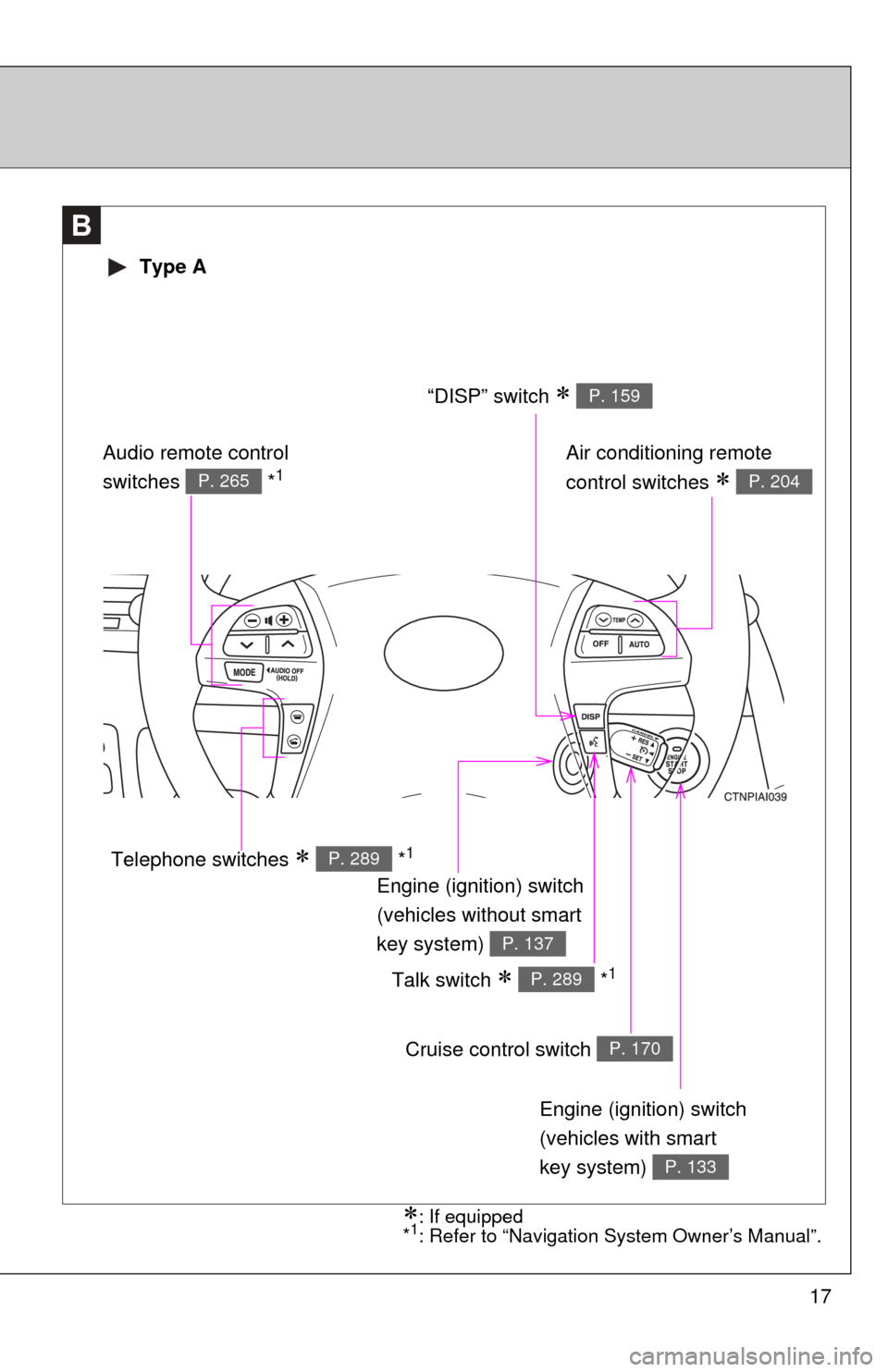
17
B
Engine (ignition) switch
(vehicles with smart
key system)
P. 133
Cruise control switch P. 170
Talk switch *1P. 289
Air conditioning remote
control switches
P. 204
Engine (ignition) switch
(vehicles without smart
key system)
P. 137
“DISP” switch P. 159
Telephone switches *1P. 289
Audio remote control
switches *1P. 265
Type A
: If equipped
*1: Refer to “Navigation System Owner’s Manual”.
Page 18 of 554
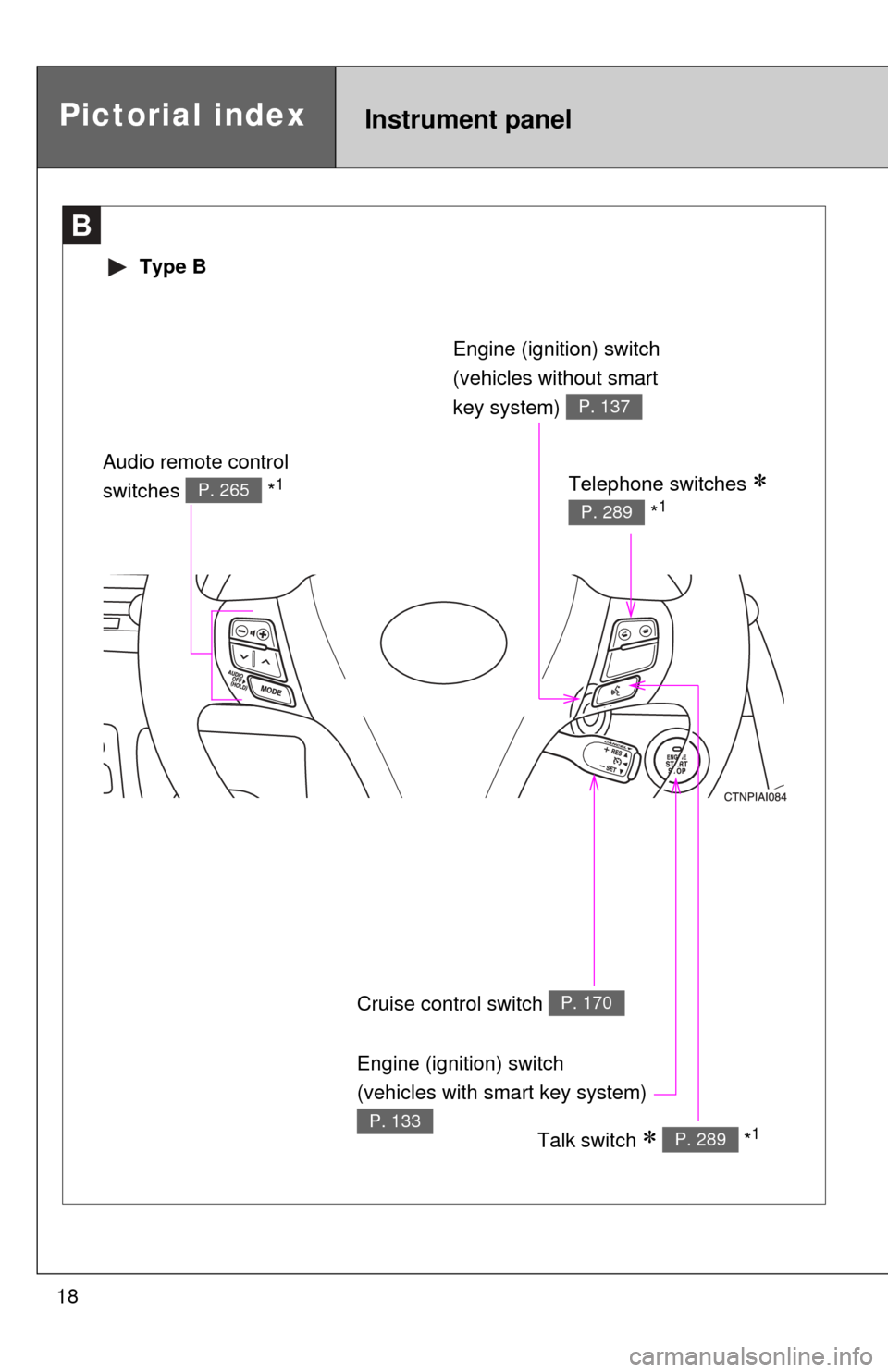
18
B
Type B
Cruise control switch P. 170
Talk switch *1P. 289
Engine (ignition) switch
(vehicles without smart
key system)
P. 137
Telephone switches
*1P. 289
Audio remote control
switches *1P. 265
Pictorial indexInstrument panel
Engine (ignition) switch
(vehicles with smart key system)
P. 133
Page 21 of 554

21
Installation of a mobile two-way radio system
As the installation of a mobile two-way radio system in your vehicle may
affect electronic systems such as the multi-port fuel injection system/sequen-
tial multi-port fuel injection system, cruise control system, anti-lock brake
system, SRS airbag system or seat belt pretensioner system, be sure to
check with your Toyota dealer for precautionary measures or special instruc-
tions regarding installation.
Scrapping of your Toyota
The SRS airbag and seat belt pretensioner devices in your Toyota contain
explosive chemicals. If the vehicle is scrapped with the airbags and seat belt
pretensioners left as they are, this may cause an accident such as fire. Be
sure to have the systems of the SRS airbag and seat belt pretensioner
removed and disposed of by a qualified service shop or by your Toyota
dealer before you scrap your vehicle.
Perchlorate Material
Special handling may apply, See www.dtsc.ca.gov/hazardouswaste/perchlorate.
Your vehicle has components that may contain perchlorate. These compo-
nents may include airbags, seat belt pretensioners, and wireless remote con-
trol batteries.
Page 121 of 554
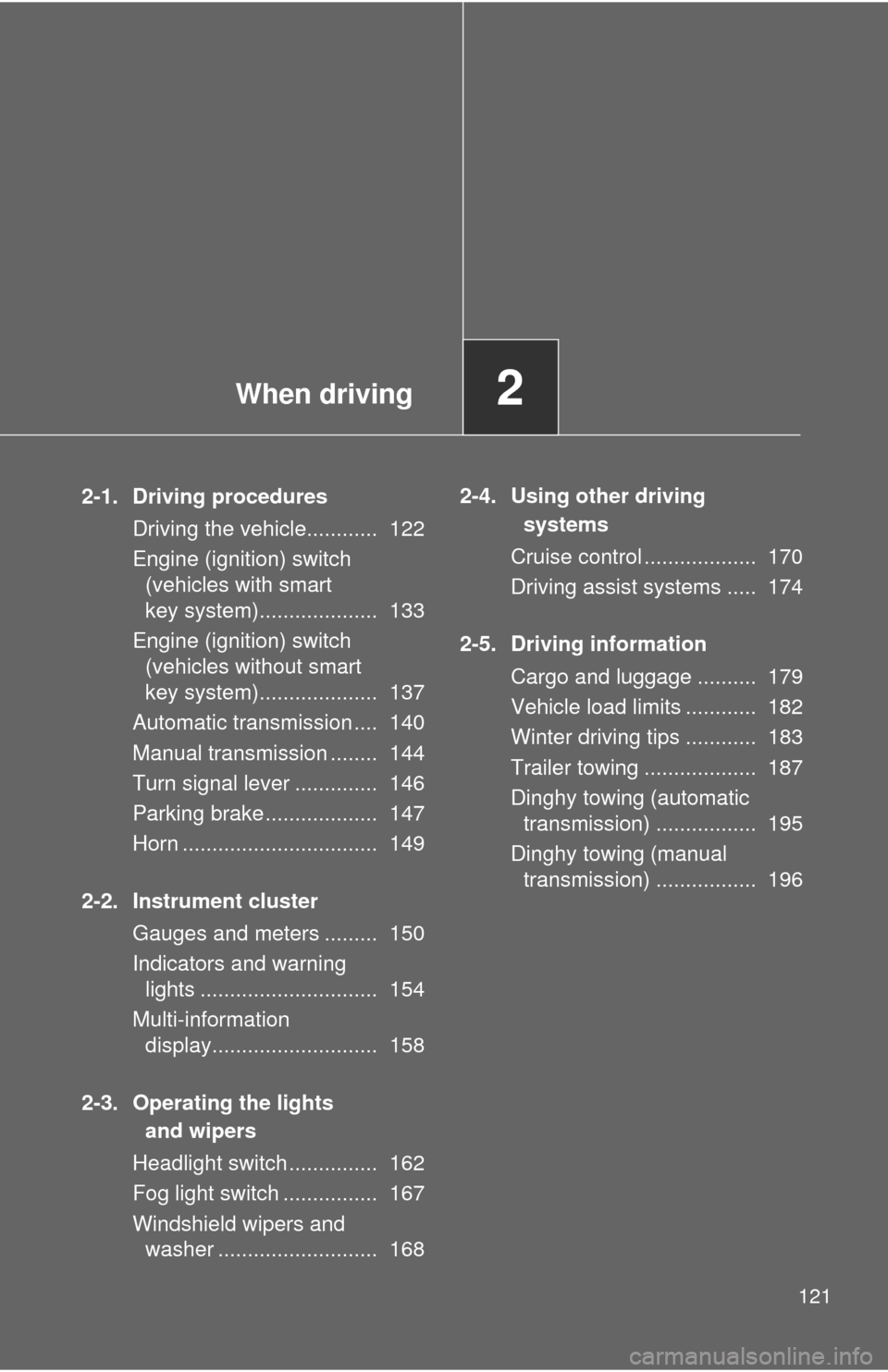
When driving2
121
2-1. Driving proceduresDriving the vehicle............ 122
Engine (ignition) switch (vehicles with smart
key system).................... 133
Engine (ignition) switch (vehicles without smart
key system).................... 137
Automatic transmission .... 140
Manual transmission ........ 144
Turn signal lever .............. 146
Parking brake ................... 147
Horn ................................. 149
2-2. Instrument cluster Gauges and meters ......... 150
Indicators and warning lights .............................. 154
Multi-information display............................ 158
2-3. Operating the lights and wipers
Headlight switch ............... 162
Fog light switch ................ 167
Windshield wipers and washer ........................... 168 2-4. Using other driving
systems
Cruise control ................... 170
Driving assist systems ..... 174
2-5. Driving information Cargo and luggage .......... 179
Vehicle load limits ............ 182
Winter driving tips ............ 183
Trailer towing ................... 187
Dinghy towing (automatic transmission) ................. 195
Dinghy towing (manual transmission) ................. 196
Page 142 of 554

142 2-1. Driving procedures
■Shift ranges and their functions
A lower shift range will provide greater engine braking force than a
higher shift range.
■ Downshifting restrictions
To help ensure safety and driving performance, downshifting operation may
sometimes be restricted. In some circumstances, downshifting may not be
possible even when the shift lever is operated. (The warning buzzer will
sound twice.)
■ When driving with the cruise control system
Engine braking will not occur during shift range selection in the D position or
S mode, even when downshifting to range 5 or 4. ( P. 170)
■ If the shift lever cannot be shifted from P
P. 471
Shift rangeFunction
6 A gear between 1 and 6 is automatically selected
according to vehicle speed and driving conditions.
5 A gear between 1 and 5 is automatically selected
according to vehicle speed and driving conditions.
4 A gear between 1 and 4 is automatically selected
according to vehicle speed and driving conditions.
3 A gear between 1 and 3 is automatically selected
according to vehicle speed and driving conditions.
2 A gear between 1 and 2 is automatically selected
according to vehicle speed and driving conditions.
1 Setting the gear at 1.
Page 156 of 554
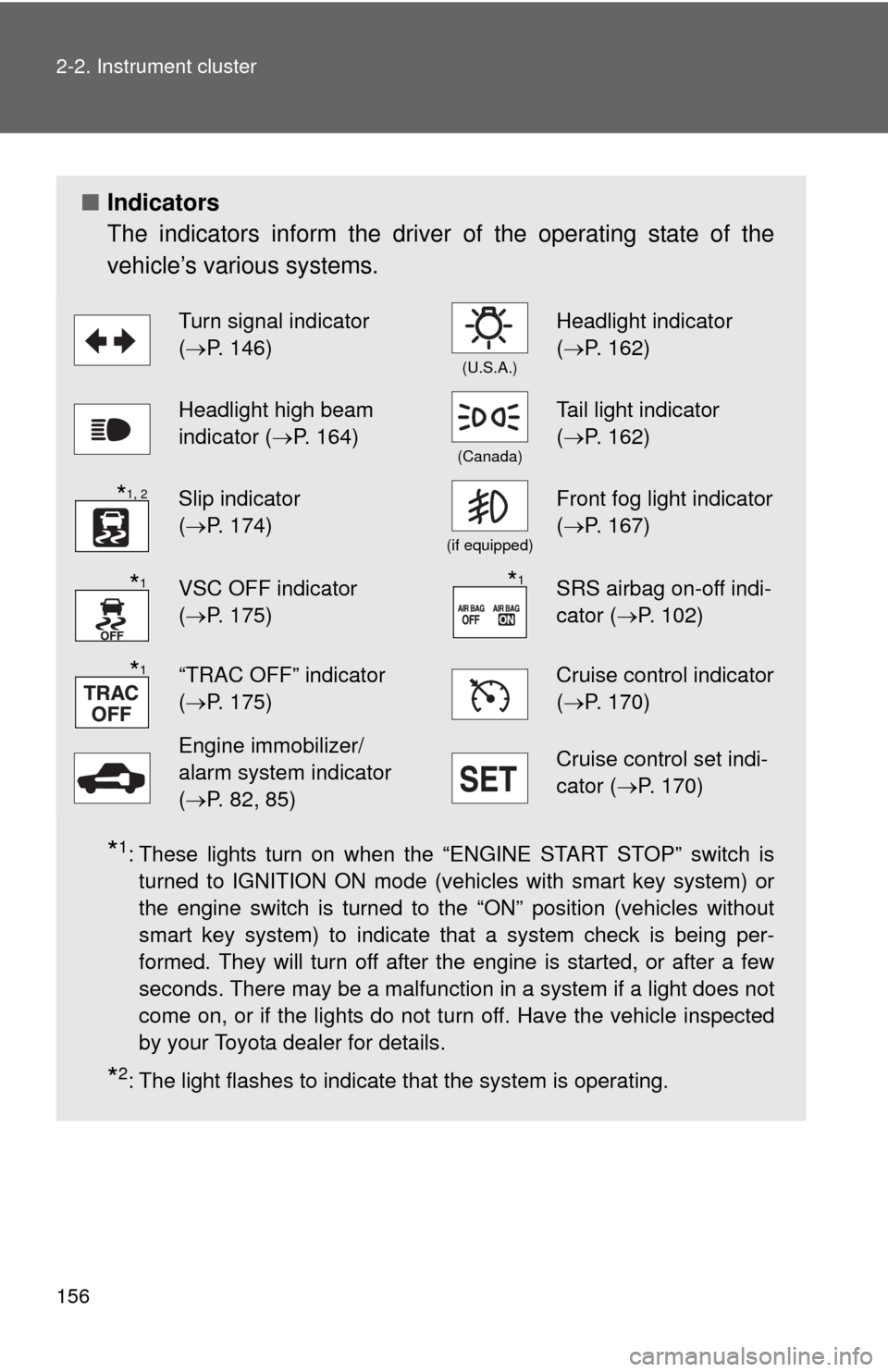
156 2-2. Instrument cluster
■Indicators
The indicators inform the driver of the operating state of the
vehicle’s various systems.
*1: These lights turn on when the “ENGINE START STOP” switch is
turned to IGNITION ON mode (vehicles with smart key system) or
the engine switch is turned to the “ON” position (vehicles without
smart key system) to indicate that a system check is being per-
formed. They will turn off after the engine is started, or after a few
seconds. There may be a malfunction in a system if a light does not
come on, or if the lights do not turn off. Have the vehicle inspected
by your Toyota dealer for details.
*2: The light flashes to indicate that the system is operating.
Turn signal indicator
(P. 146)
(U.S.A.)
Headlight indicator
( P. 162)
Headlight high beam
indicator ( P. 164)
(Canada)
Tail light indicator
(P. 162)
Slip indicator
(P. 174)
(if equipped)
Front fog light indicator
( P. 167)
VSC OFF indicator
(P. 175)SRS airbag on-off indi-
cator (P. 102)
“TRAC OFF” indicator
(P. 175)Cruise control indicator
( P. 170)
Engine immobilizer/
alarm system indicator
(P. 82, 85)Cruise control set indi-
cator (P. 170)
*1, 2
*1*1
*1
Page 170 of 554
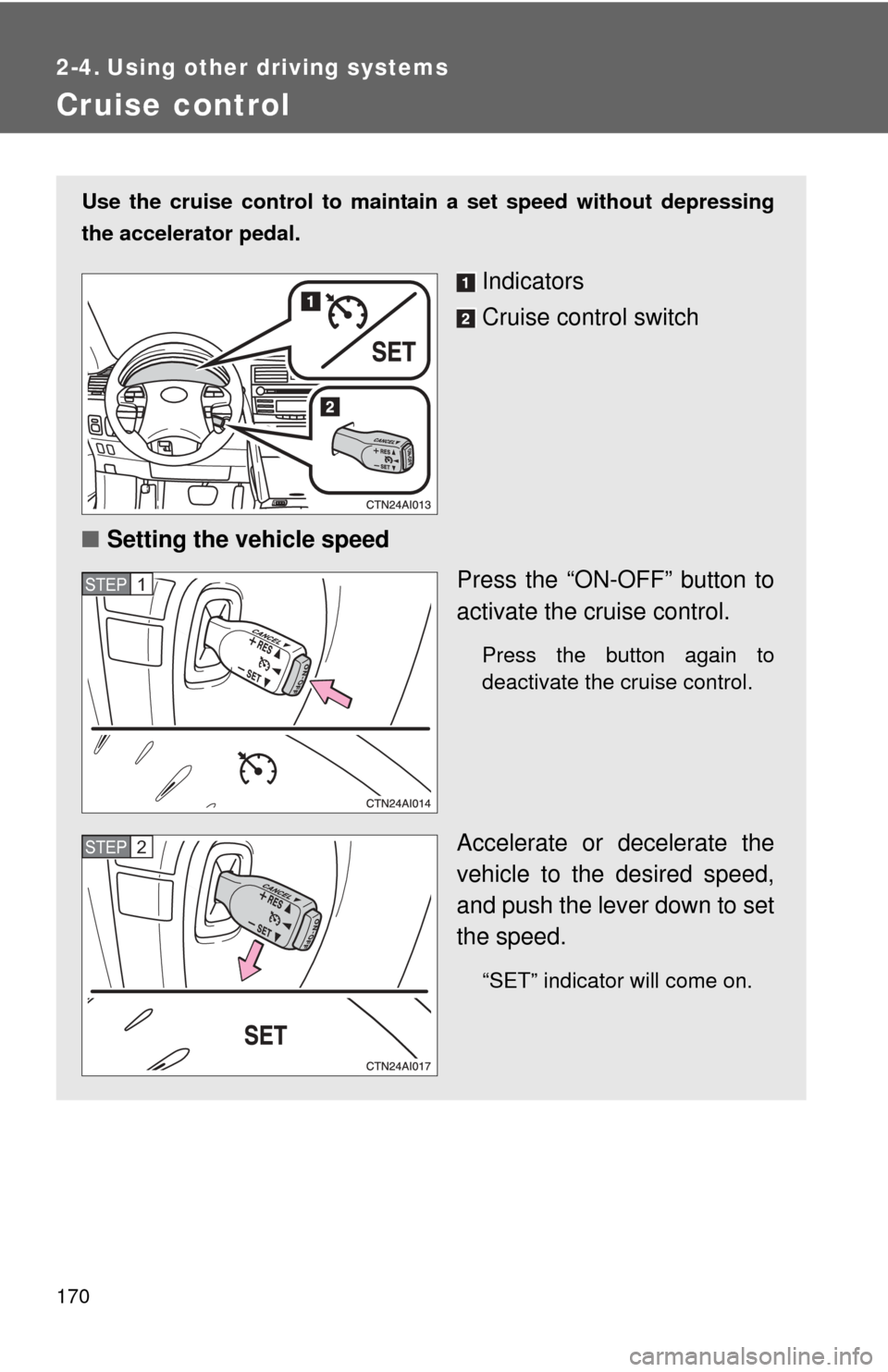
170
2-4. Using other driving systems
Cruise control
Use the cruise control to maintain a set speed without depressing
the accelerator pedal.
Indicators
Cruise control switch
■ Setting the vehicle speed
Press the “ON-OFF” button to
activate the cruise control.
Press the button again to
deactivate the cruise control.
Accelerate or decelerate the
vehicle to the desired speed,
and push the lever down to set
the speed.
“SET” indicator will come on.
STEP1
STEP2
Page 172 of 554
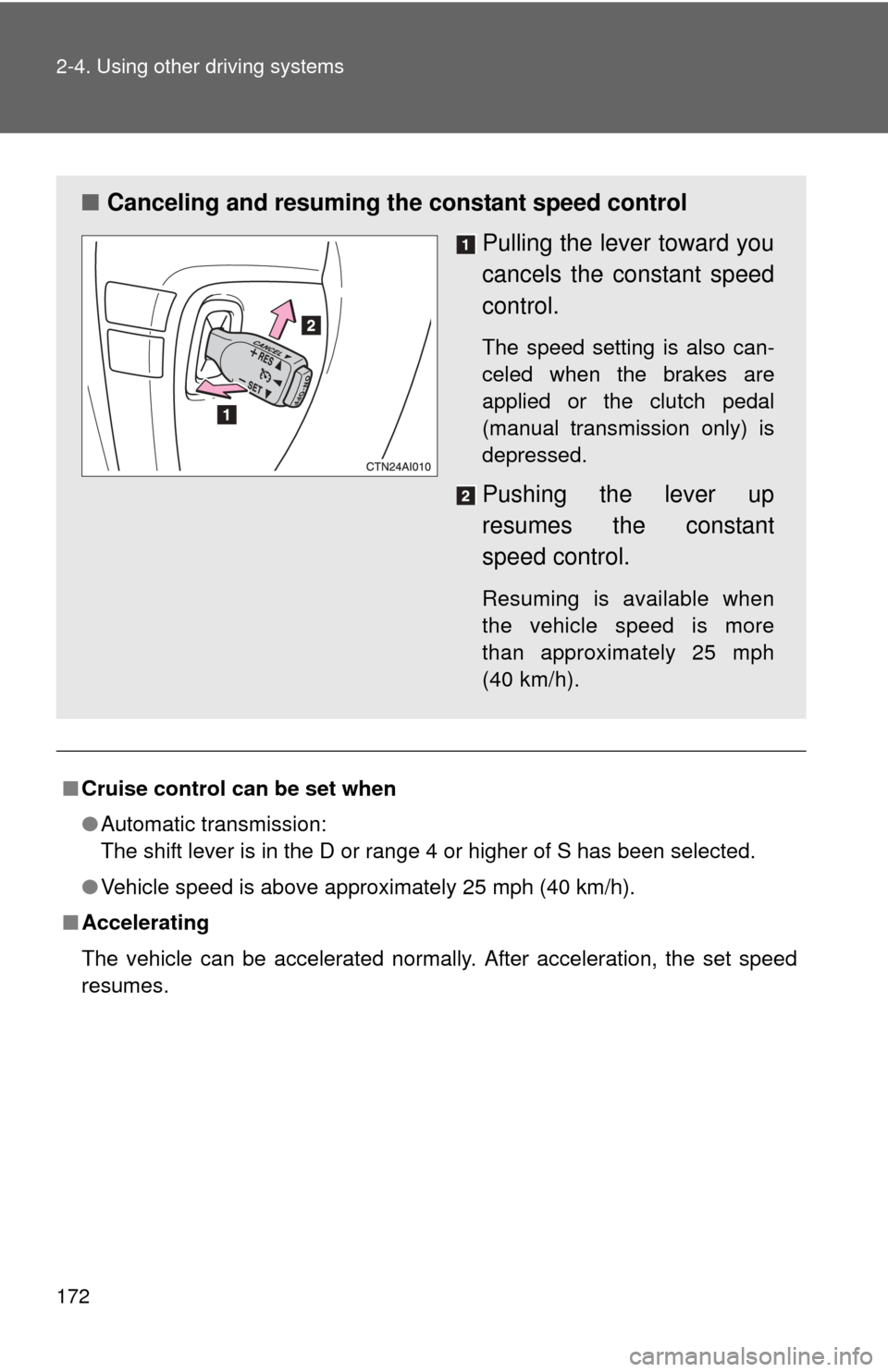
172 2-4. Using other driving systems
■Cruise control can be set when
●Automatic transmission:
The shift lever is in the D or range 4 or higher of S has been selected.
● Vehicle speed is above approximately 25 mph (40 km/h).
■ Accelerating
The vehicle can be accelerated normally. After acceleration, the set speed
resumes.
■ Canceling and resuming the constant speed control
Pulling the lever toward you
cancels the constant speed
control.
The speed setting is also can-
celed when the brakes are
applied or the clutch pedal
(manual transmission only) is
depressed.
Pushing the lever up
resumes the constant
speed control.
Resuming is available when
the vehicle speed is more
than approximately 25 mph
(40 km/h).
Page 173 of 554
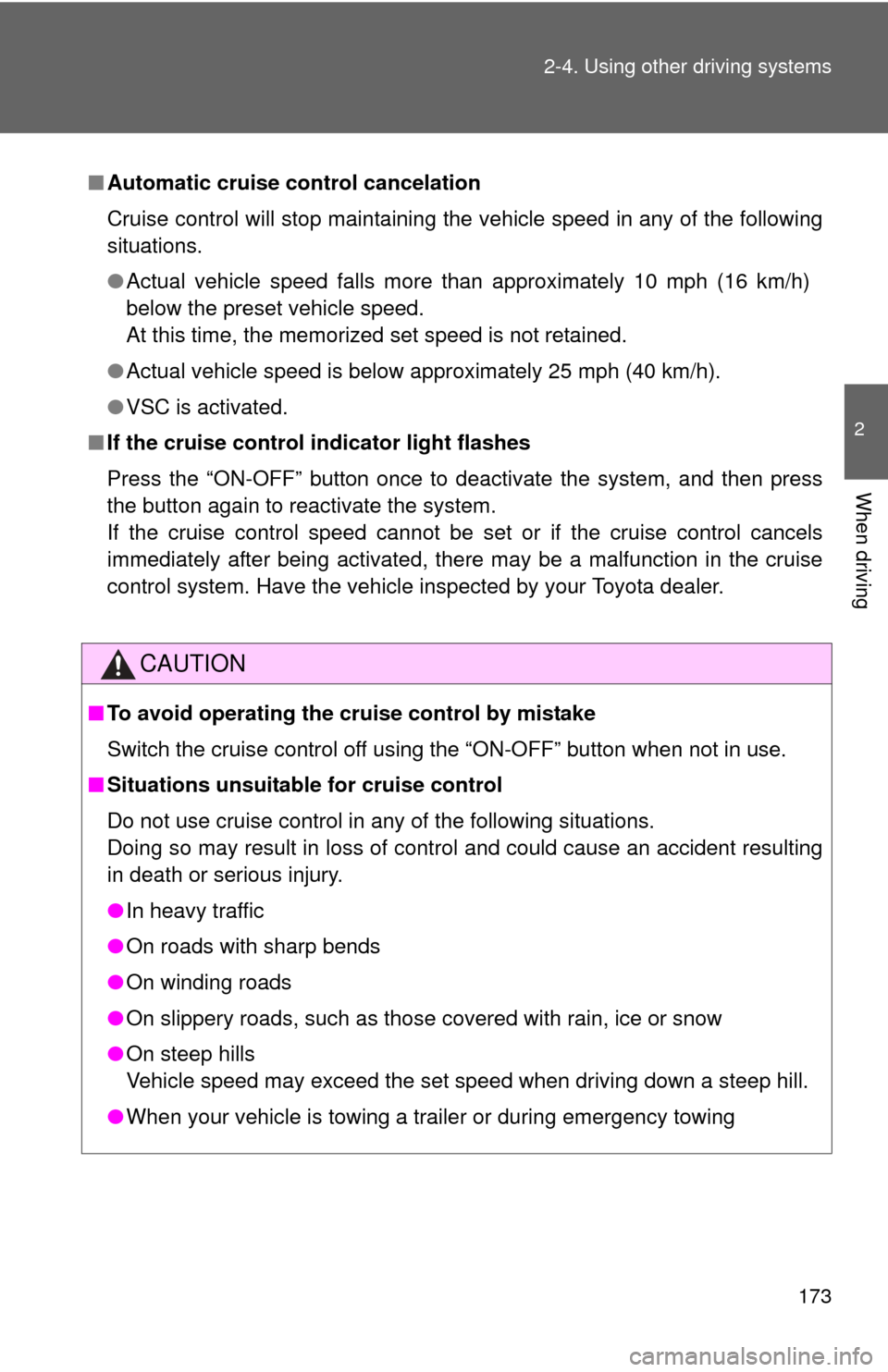
173
2-4. Using other
driving systems
2
When driving
■Automatic cruise control cancelation
Cruise control will stop maintaining the vehicle speed in any of the following
situations.
●Actual vehicle speed falls more than approximately 10 mph (16 km/h)
below the preset vehicle speed.
At this time, the memorized set speed is not retained.
● Actual vehicle speed is below approximately 25 mph (40 km/h).
● VSC is activated.
■ If the cruise control indicator light flashes
Press the “ON-OFF” button once to deactivate the system, and then press
the button again to reactivate the system.
If the cruise control speed cannot be set or if the cruise control cancels
immediately after being activated, there may be a malfunction in the cruise
control system. Have the vehicle inspected by your Toyota dealer.
CAUTION
■ To avoid operating the cruise control by mistake
Switch the cruise control off using the “ON-OFF” button when not in use.
■ Situations unsuitable for cruise control
Do not use cruise control in any of the following situations.
Doing so may result in loss of control and could cause an accident resulting
in death or serious injury.
●In heavy traffic
● On roads with sharp bends
● On winding roads
● On slippery roads, such as those covered with rain, ice or snow
● On steep hills
Vehicle speed may exceed the set speed when driving down a steep hill.
● When your vehicle is towing a trailer or during emergency towing